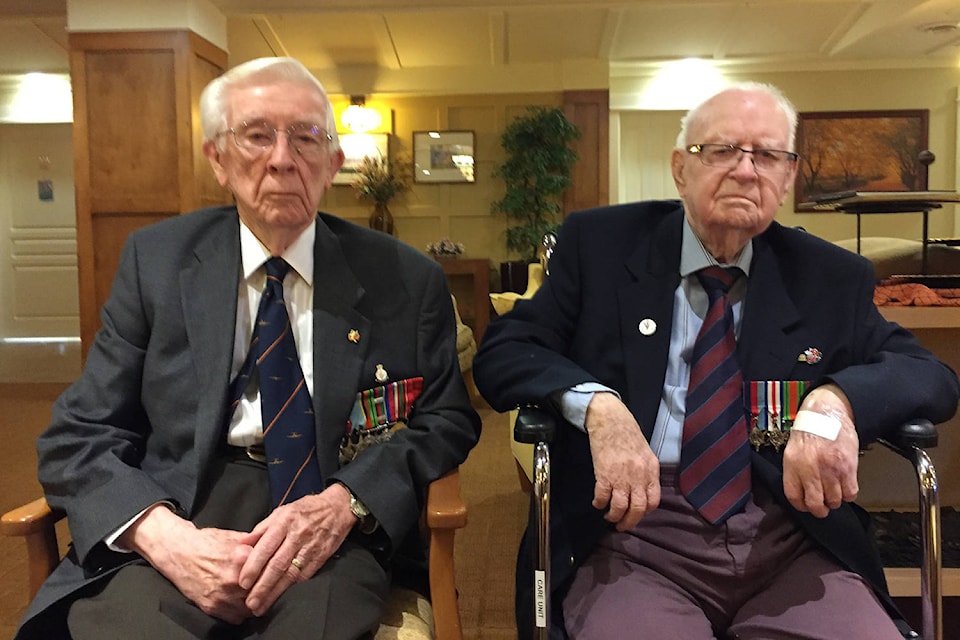Reginald Price and Les Taylor are among 61,000 surviving Canadian veterans of the Second World War. Price is 96 years old, Taylor 100, having crossed the century-mark in October. While both currently live at Berwick Royal Oak, their experiences during and after history’s largest conflict differ in many ways.
Price served as a Lancester pilot in Bomber Command, flying 31 missions between October 1943 and May 1944 over German-occupied Europe and Germany itself, with eight missions over Berlin, “one of the most hazardous places,” as he says. Price also participated in the March 1944 raid over Nuremberg, the costliest mission in the history of Bomber Command, which lost 106 planes and 545 men.
But Price speaks off these events with a matter-of-fact tone, as if describing a trip to the dentist, necessary, but not necessarily impactful. For Price, the war was “one of those things that happened a long time ago” that will “hopefully…never happen again.”
His memories revolve around the vagaries of military bureaucracy, like the one that ended his active service. While waiting for a mission briefing, Price and his multi-national crew of Australians and English airmen received word that two previous bombing raids over French railroad yards once again counted as full rather than one-third missions. This change gave them 31 missions, one over the number required to be rotated out of combat action.
Several months later, a German air raid killed one of his crew members, when he was visiting his family in North London, two weeks shy of his 21st birthday.
“One of the unfortunate aspects of war is that people get killed,” he says. Did Price ever experience what one might call survivor-guilt? “No, not really,” he says. “I don’t think I really thought about that, although obviously, we’re quite lucky to survive.”
Price continues to meet other veterans through the Vancouver Island Aircrew Association, a group for former and current aircrews, to talk about various subjects, but not necessarily the war. When asked whether he ever cursed the war, Price said he never really thought about it. “It’s one of those things that happened,” he said. “I seldom think about the war. I have done so many more interesting things after it.” That includes a long career as a pilot, flying commercial jets for the last 20 years of it.
Taylor, meanwhile, remembers little of the war now, and perhaps that might be a blessing. Taylor landed as a lieutenant with the Queen’s Own Cameron Highlanders based out of Winnipeg in France’s Normandy region shortly after D-Day on June 6, 1944. Confronting the Camerons was the 12th SS Panzer Division (Hitler Youth), an elite German unit notorious for its battle fanaticism and war crimes committed against both civilians and captured soldiers, including Canadians.
Fighting near the city of Caen and the Falaise Gap during the summer of 1944, Taylor earned a battle field commission to captain, but also suffered a shrapnel injury. “We had taken [two] German prisoners, when I was hit by mortar shrapnel, which went right through my lower left leg, breaking my leg and coming out of the back,” he wrote in a book that his family published later. “I was not in pain, just numb…the pain came later.” More than 70 years later, Taylor touches his leg to show where he suffered the wound.
Other details of this period in Taylor’s life would have long faded away, were it not for his book. Flip through it, and a personal century unspools in front of you. It shows Taylor as a young man and father of two during the 1930s as the world prepared for the war, and as a proud father of four (three girls, one boy) and grandfather in its prosperous aftermath. It points to a fully lived life in and around Victoria, far removed from the horrors of war.
“I have erased it from my mind,” says Taylor, when asked whether he finds it difficult to speak about his experience.
But his eyes light up when asked about the number of his grandchildren. “I have too many,” he says. “I have lost count.”
